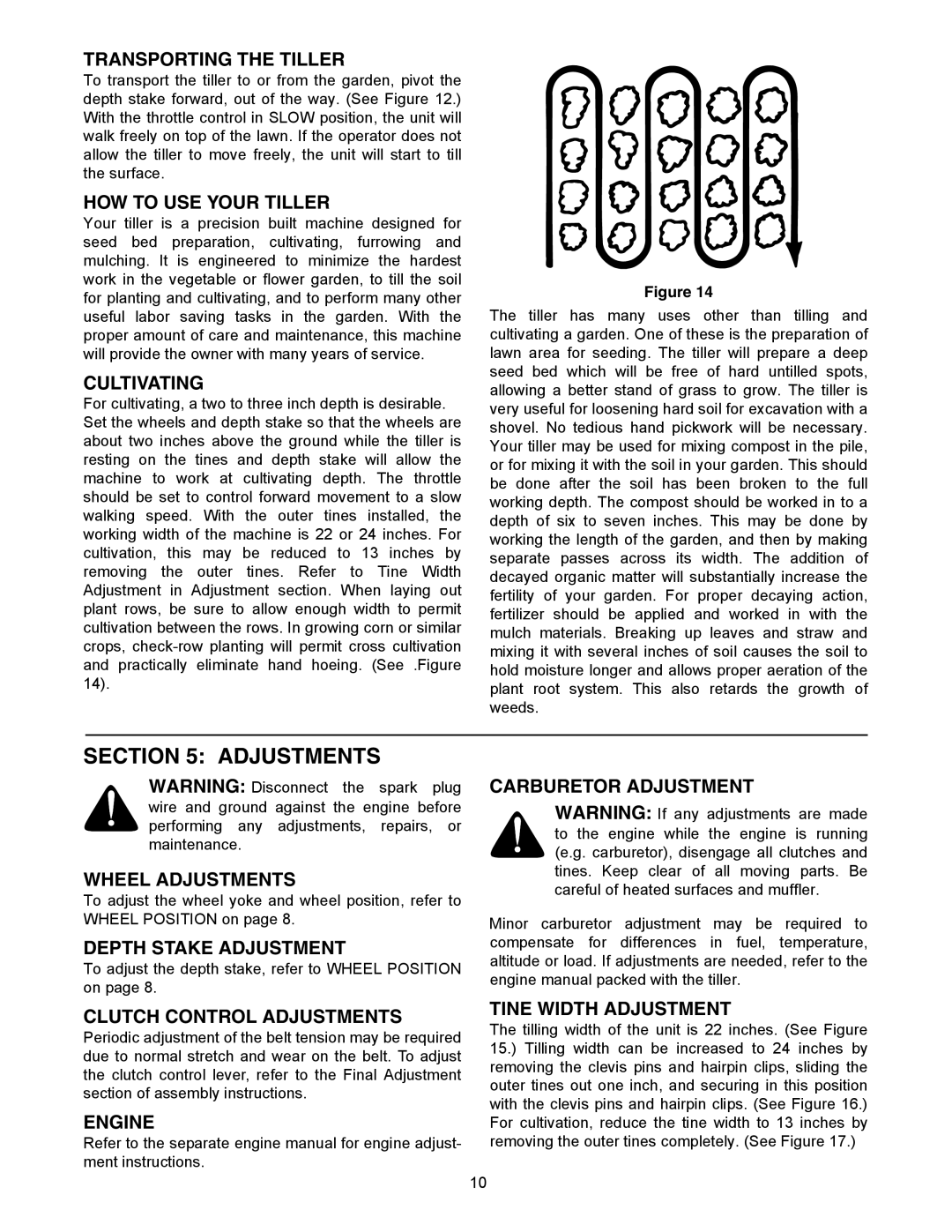
TRANSPORTING THE TILLER
To transport the tiller to or from the garden, pivot the depth stake forward, out of the way. (See Figure 12.) With the throttle control in SLOW position, the unit will walk freely on top of the lawn. If the operator does not allow the tiller to move freely, the unit will start to till the surface.
HOW TO USE YOUR TILLER
Your tiller is a precision built machine designed for seed bed preparation, cultivating, furrowing and mulching. It is engineered to minimize the hardest work in the vegetable or flower garden, to till the soil for planting and cultivating, and to perform many other useful labor saving tasks in the garden. With the proper amount of care and maintenance, this machine will provide the owner with many years of service.
CULTIVATING
For cultivating, a two to three inch depth is desirable. Set the wheels and depth stake so that the wheels are about two inches above the ground while the tiller is resting on the tines and depth stake will allow the machine to work at cultivating depth. The throttle should be set to control forward movement to a slow walking speed. With the outer tines installed, the working width of the machine is 22 or 24 inches. For cultivation, this may be reduced to 13 inches by removing the outer tines. Refer to Tine Width Adjustment in Adjustment section. When laying out plant rows, be sure to allow enough width to permit cultivation between the rows. In growing corn or similar crops,
Figure 14
The tiller has many uses other than tilling and cultivating a garden. One of these is the preparation of lawn area for seeding. The tiller will prepare a deep seed bed which will be free of hard untilled spots, allowing a better stand of grass to grow. The tiller is very useful for loosening hard soil for excavation with a shovel. No tedious hand pickwork will be necessary. Your tiller may be used for mixing compost in the pile, or for mixing it with the soil in your garden. This should be done after the soil has been broken to the full working depth. The compost should be worked in to a depth of six to seven inches. This may be done by working the length of the garden, and then by making separate passes across its width. The addition of decayed organic matter will substantially increase the fertility of your garden. For proper decaying action, fertilizer should be applied and worked in with the mulch materials. Breaking up leaves and straw and mixing it with several inches of soil causes the soil to hold moisture longer and allows proper aeration of the plant root system. This also retards the growth of weeds.
SECTION 5: ADJUSTMENTS
WARNING: Disconnect the spark plug wire and ground against the engine before performing any adjustments, repairs, or maintenance.
WHEEL ADJUSTMENTS
To adjust the wheel yoke and wheel position, refer to WHEEL POSITION on page 8.
DEPTH STAKE ADJUSTMENT
To adjust the depth stake, refer to WHEEL POSITION on page 8.
CLUTCH CONTROL ADJUSTMENTS
Periodic adjustment of the belt tension may be required due to normal stretch and wear on the belt. To adjust the clutch control lever, refer to the Final Adjustment section of assembly instructions.
ENGINE
Refer to the separate engine manual for engine adjust- ment instructions.
CARBURETOR ADJUSTMENT
WARNING: If any adjustments are made to the engine while the engine is running (e.g. carburetor), disengage all clutches and tines. Keep clear of all moving parts. Be careful of heated surfaces and muffler.
Minor carburetor adjustment may be required to compensate for differences in fuel, temperature, altitude or load. If adjustments are needed, refer to the engine manual packed with the tiller.
TINE WIDTH ADJUSTMENT
The tilling width of the unit is 22 inches. (See Figure 15.) Tilling width can be increased to 24 inches by removing the clevis pins and hairpin clips, sliding the outer tines out one inch, and securing in this position with the clevis pins and hairpin clips. (See Figure 16.) For cultivation, reduce the tine width to 13 inches by removing the outer tines completely. (See Figure 17.)
10
